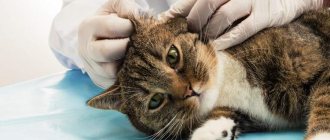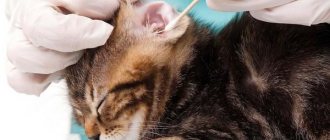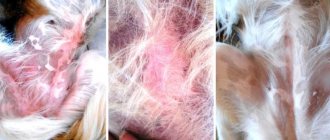Causes
There are not many reasons for the development of this or that disease. They are related to hygiene and structural features of the ears:
- Water ingress.
- Injuries.
- Allergies.
- Infections.
- Parasites.
- Lack of proper care for representatives of breeds with hanging ears.
- Heredity.
- Hormonal imbalance.
Symptoms
It is quite easy to determine that an animal has problems with its ears, since the dog itself tries to show with its behavior and appearance that it has problems:
- Moves his head from side to side, as if something is stuck in his ear.
- Constantly scratches the problem area.
- Tries to rub the side of his head against all surfaces.
- Actively rolls on the ground , while trying to scratch the side of its head on the floor.
- Walks, constantly tilting his head to the same side.
- Reacts to touch , aggressively or cowardly, tries not to fall into the hands of the owner, interferes with examining the sore spot.
There are no asymptomatic diseases of this organ in animals. If your pet's behavior seems strange to you, examine the ears, you will immediately notice the following manifestations:
- Redness of the mucous membrane and the entire internal surface from pale pink to bright red.
- Strong unpleasant odor . It can be putrid, sour, sickly sweet, depending on the problem causing it.
- Swelling in the internal areas.
- Increased ear discharge . It can be either pus or simple sulfur. Pay attention to the “standard” amount of sulfur removed during daily cleaning in order to immediately notice its hyperexcretion.
READ ALSO: Dog's ear is swollen
Some diseases appear almost instantly, and in other cases, more than one day passes from the onset of development to pronounced symptoms, so do not delay going to the vet after identifying the first disturbing signs.
Purulent form of otitis
Of particular danger to the animal is purulent otitis media, which can cause irreversible consequences.
Onset of the disease
The pathological process begins to develop due to serous inflammation or activation of pathogenic bacteria. The situation worsens when a secondary infection penetrates the affected hearing organs.
Mites or sulfur plugs are provocateurs of the development of pathology
Parasites, especially ticks, can provoke such changes.
Lesions are observed in the presence of wax plugs, so it is important to regularly clean your pet’s ears.
Ear discharge
A number of characteristic symptoms indicate a purulent form of pathology.
The animal suffers from pain; when pressure is applied to the affected organ, a squelching sound is heard. There is an unpleasant strong odor and the release of purulent exudate.
Diseases and methods of their treatment
Only a veterinarian can accurately determine a specific disease based on its symptoms, the cause of its occurrence, and select the appropriate medications and dosages for treatment, after a special study, since many diseases have the same manifestations. However, pets with damaged ears are often treated at home on their own.
Otitis
This name covers several types of ear inflammation. Moreover, they can be caused by various pathogens.
Working dogs often get sick with it: hunting dogs, herding dogs, those who spend time in nature and bathe in various bodies of water. Fold-eared breeds suffer the worst.
The main symptoms at various stages are:
- Pain when trying to open the mouth.
- Discharge from the eyes.
- Deafness.
- Edema.
- Formation of pus.
Treatment of otitis media, even in a mild form, cannot be delayed for a day, since in some cases it develops rapidly and threatens to cause pus to enter the brain. In particularly advanced cases, irreversible consequences such as deafness and even the death of the pet are possible.
There are three forms of otitis media:
- Outdoor . This form develops both as a complication of skin diseases and as an independent problem. In this case, the inflammation is localized to the eardrum. From the very first day it can be identified visually. Most photos show otitis externa.
- The average one is manifested by pinching of the nerves of the muzzle and pain when opening the mouth and yawning. Usually located just behind the eardrum.
- The internal one is the most dangerous, since it will not be possible to accurately make this diagnosis based on the external manifestations of the house. The most common signs are incoordination when walking and swaying eyes.
If you are sure that the animal is developing otitis media, then you can provide first aid to the dog at home. To do this, you need to thoroughly rinse the auricle, remove all dirt and crusts, treat the wounds with brilliant green, if any, and drip a painkiller.
Productive treatment that can not only relieve the primary symptoms, but also remove the cause of the condition. Medicines are prescribed only by a veterinarian after a thorough examination. But all procedures are carried out at home. Typically, otitis media is treated depending on the underlying cause:
- For fungal ear infections, treat them with phosphoric acid.
- In case of purulence , all secreted fluids are removed, and then treated with a disinfecting solution and a course of antibiotics is prescribed.
- Allergies are the easiest to cure. This requires local treatment with special preparations and a hypoallergenic diet.
Otodecosis
Otodecosis is an inflammation that begins after an ear mite penetrates the auditory canal. Already at the initial stages, the reason for the dog’s poor health is clear, since mites live in the skin, gnawing passages and eating particles.
Crusts will form inside and active release of sulfur will begin. Under no circumstances should treatment be delayed, since if the parasites penetrate to the eardrum and further, the animal may become deaf. In the most advanced cases, meningitis develops.
You can save your pet at home by treating the affected area with special anti-parasite medications, which can be found in any veterinary pharmacy. However, if otodecosis is already in an advanced form, you need to contact a veterinarian to do research and determine the extent of the damage caused.
Why does my dog's ear hurt/itch?
Such troubles can be caused by bacteria, viruses and microscopic mites that cause otitis media, as well as wax plugs, cold water getting into the ear, etc. Fold-eared dogs often suffer from ear problems, as their ears are worse at airflow.
The main “ear” problems of dogsOtitis: external, middle or internal. In the first case, the area between the eardrum and the opening of the ear canal becomes inflamed. With otitis media, inflammation covers the area behind the eardrum, and with internal otitis – the labyrinth of the ear. Perhaps there is no need to explain which otitis media is easier to treat? |
| Ear scabies or otodectosis. The disease is caused by an invisible tick, Otodectos cynotis, which is easy to “pick up” while walking or in contact with a sick animal. The mite occupies the auricle and external auditory canal, but can also penetrate the middle and inner ear. This threatens the dog with meningitis, and its complications are the worst... So don’t delay treatment. |
| Eczema, dermatitis. Most often this is a consequence of an allergy to plant pollen that has entered the ear, some chemicals or food. Because of the irritant, the ear becomes red and itchy, and the dog begins to “help” itself: shakes its head, scratches the ear... After this, an infection that the dog brought to the affected area may join the allergy. |
| Ear injuries. |
| Congenital diseases and hormonal disorders. |
Deafness
Depending on the time of occurrence, it is divided into two types:
- Congenital and untreatable. Even special hearing restoration techniques are most often ineffective. If the puppy was born deaf, then nothing can be done.
- Acquired as a result of illness, injury or excessive sound exposure is corrected. First of all, the root cause is removed, and then the necessary therapy is carried out.
Treatment of the disease
Treatment tactics are selected by the veterinarian on an individual basis, taking into account the characteristics of the course of the disease and the general condition of the dog.
Prohibition on self-medication
Treating an animal on your own, without resorting to the help of specialists, is strictly prohibited.
Incorrect actions by an inexperienced owner can lead to the development of serious complications and even the death of the pet.
What medications and procedures are prescribed?
Therapy is aimed at performing the following tasks:
elimination of pain, itching, swelling;- removal of toxins;
- eliminating secretions by cleaning the ear canals;
- destruction of pathogenic microorganisms;
- eliminating the root cause;
- activation of the body's protective functions.
If the ear canals become overgrown, a foreign object gets in, or tumors appear, surgical intervention is often resorted to.
Treatment methods are selected depending on the form of the pathology.
For example, for chronic inflammation, not only antibacterial but also antifungal agents are prescribed; for fungal infections, antimycotic drugs are prescribed. If otitis media is caused by an allergy, antihistamines are used and a diet is indicated.
Precautionary measures
The dog's ears are treated very carefully. Before performing the procedure, you must calm your pet. It wouldn't hurt to put a muzzle on him.
It is advisable to enlist the help of another person to hold the dog. A clean cotton swab is used for each ear to prevent infection.
Prevention
Although ear diseases are treatable and rarely leave behind serious complications, it is still better to prevent them. This is possible if you follow the ear care rules daily.
Grooming techniques depend on the specific breed, but there are procedures necessary for all pets:
- Regularly clean the ear from dirt using a damp cotton swab.
- During bathing, it is necessary to protect the auricle from water. If this has already happened, wipe thoroughly with a dry cloth.
- Remove hair from inside the ear regularly . Depending on the breed, this can be done with depilatory cream or tweezers if the hairs are hard.
- If you detect even slight redness, do not delay and immediately contact your veterinarian to determine the cause of the symptom.
Symptoms of ear diseases in dogs
Contact your veterinarian immediately if your four-legged friend has
- red, swollen and inflamed ear
- there is pus, crusts or ulcers in the ear
- behavior has changed (the dog shakes its head and rubs it on furniture, scratches its ear, tilts its head to the side, whines when its ear or muzzle is touched).
Symptoms of ear diseases in dogs are often similar. To accurately determine their cause, you need the experienced eye of a veterinarian and tests. The examination will show whether everything can be managed with medications and drops or whether surgical treatment will be required.











